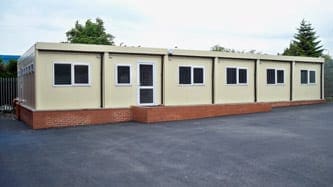Modular Buildings For Healthcare
 Cost-reduction and shortening of construction schedules remain as the primary focus areas of healthcare providers that look to invest in capital improvement projects. With superior design and high-quality building materials being considered as basic construction parameters, it might seem that it is practically impossible to run construction projects faster and in a cost-effective manner. However, the introduction of modular construction technology has defied the conventional assumption by setting a construction trend that is noted for its time-efficiency and superiority in terms of design as well as material quality.
Cost-reduction and shortening of construction schedules remain as the primary focus areas of healthcare providers that look to invest in capital improvement projects. With superior design and high-quality building materials being considered as basic construction parameters, it might seem that it is practically impossible to run construction projects faster and in a cost-effective manner. However, the introduction of modular construction technology has defied the conventional assumption by setting a construction trend that is noted for its time-efficiency and superiority in terms of design as well as material quality.
The scope of use of modular buildings in the healthcare field is large as medical service providers often need to address immediate needs for extra office or clinic space. Modular buildings come with warranty and full-service maintenance programs, which make them one of the most profitable investments for healthcare players. Modular healthcare buildings can be customized to meet additional space requirements whenever healthcare organizations need to add a new rehabilitation clinic, operating room, laboratory, emergency room, diagnostic center, or other hospital extensions in their facility. Most importantly, it is possible to establish a modern medical facility with all aesthetic specifications, even on tighter budgets.
Modular buildings, used for healthcare applications, are designed to a high standard of quality and they boast clean and safe clinical environments. The modular construction technology allows a new clinic, MRI unit, diagnostic center, dentist office, or a medical facility to be opened and brought into the fully-functional mode in just a few days and this means a lot when it comes to addressing an urgent need and serving the community in a safe and efficient manner.
Modular buildings are often used as dental offices, dialysis facilities, rehabilitation offices, mental health clinics, wellness clinics, physical therapy offices, primary care offices, diagnostic imaging centers, veterinarian offices, ambulatory care, outpatient surgery departments, and urgent care clinics. Interestingly, modular buildings can also be used as restrooms, locker rooms, cafeterias, security offices, clinics, training facilities, breakrooms, physician offices, dispatch offices, and administrative offices. Modular buildings that are used in the healthcare field stand testament to world-class technology and connectivity and they can accommodate elevators, security and surveillance systems, wall mount monitors, custom lighting, acoustical ceiling, nurses stations, vibration-resistant flooring for imaging services, patient waiting areas, specialized floor load capacity for supporting heavy medical equipment, badge entry systems, specialized energy efficient mechanical systems, and HVAC- programmable control systems for maintaining indoor air quality.
Modular building manufacturers operate with a team of prefab building construction professionals who have the expertise to deliver specialized medical facilities on time and on budget. The Miami Valley Hospital Heart and Orthopedic Center’s bed tower in Dayton, Ohio, which was the first U.S. hospital to apply modular prefabrication, features patient rooms, patient-unit overhead utilities, exam rooms, and single-toilet rooms that were constructed at assembly warehouses and then assembled on-site. The hospital accommodates 178 identical rooms on five identical floors.

Leave a Reply